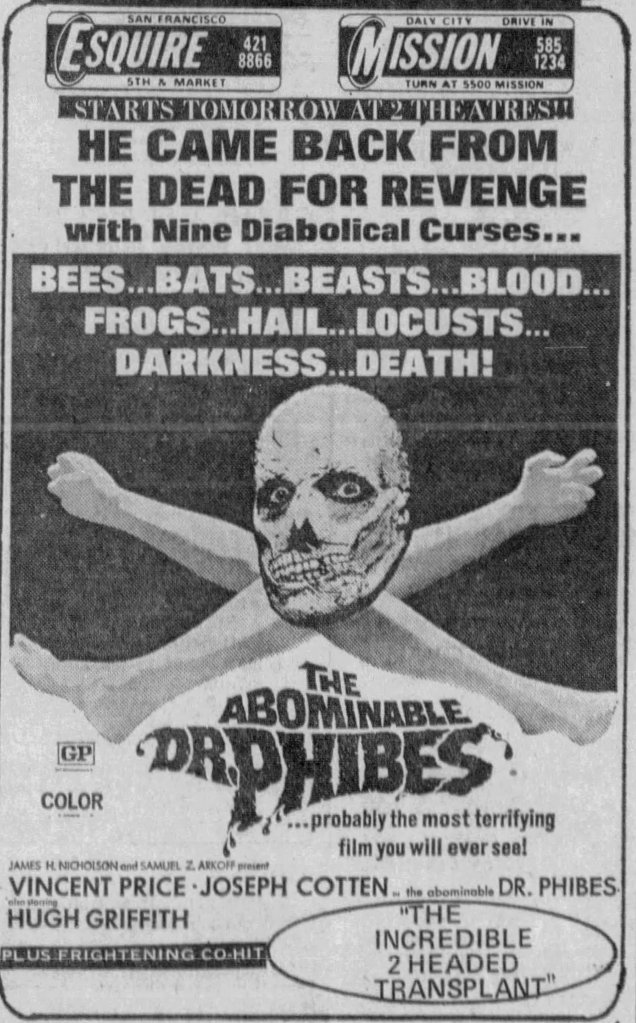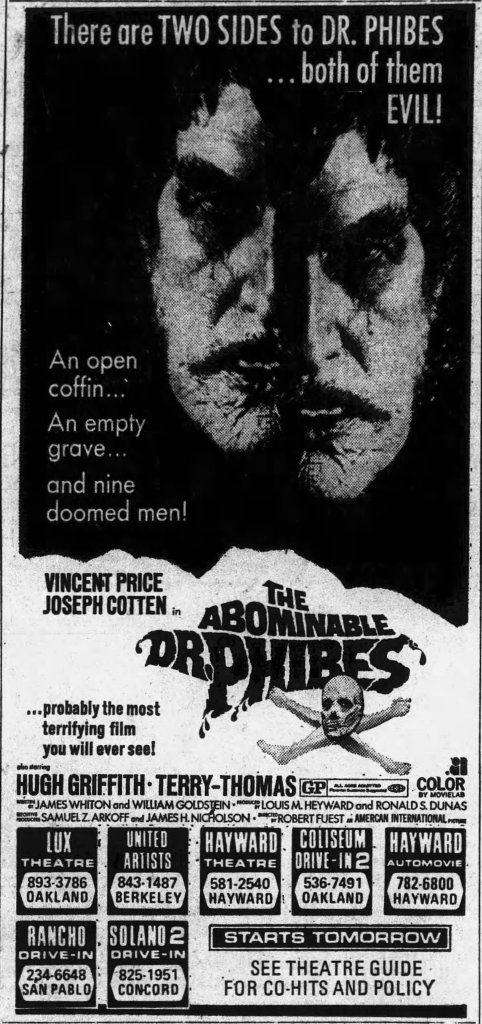




The liner notes for this CD release of Basil Kirchin’s original score for The Abominable Dr. Phibes tells quite the convoluted tale.
Like so many other low-to-medium budget independent films, the rights for The Abominable Dr. Phibes changed ownership a great many times across the years/decades. Which is the primary reason given for why the original masters have gone missing and, in the case of John Gale’s original theme for Vulnavia, may never be found. [Never say never, though.]
When composer Basil Kirchin first met Vincent Price, he asked the actor how he intended to play the titular character. Comedic or straight? “Straight,” Price replied. Armed with this knowledge, Kirchin composed the film’s score to reflect that choice.
Kirchin’s serious approach disappointed director Robert Fuest, though. Fuest thought Kirchin’s music “too austere” and “understated” and that it did not reflect the character of Anton Phibes as he understood it. That is when composer John Gale was brought in and, in Kirchin’s opinion, “spoofed up” the film’s music style.
Although the original masters are lost, composer Basil Kirchin did retain possession of a few session recordings. Against Kirchin’s wishes (again!) this album presentation is broken into separate cues that are placed in film order. Kirchin wanted his score presented in two lengthy suites that contained both used and unused music for the film.
The pipe organ performance of Mendelssohn’s War March of the Priests that plays over the opening titles is taken from the film itself and starts the album in suitably grand fashion. Track 2 contains the memorable Dr. Phibes’ Waltz, which Phibes and Vulnavia dance to just after the opening titles end.
Not contained on the album is the bombastic trumpet variation of the Dr. Phibe’s Theme used in the film. So it goes.
“I will take you to a place where my friends foregather…“
Horror writer R. Chetwynd-Hayes (John Carradine), in repayment for giving vampire Eramus (Vincent Price) a much needed snack, is allowed to visit the Monster Club. A secret location where all manner of monster can gather together, socialize, and enjoy a respite from the human world.
As the bizarre frivolity plays out around them, Eramus shares some stories with Chetwynd-Hayes…
Angela (Barbara Kellerman) and George (Simon Ward) are a pair of small time crooks looking to make a score big enough to set them up for life.
They hope robbing a strange and unsettlingly recluse named Raven (James Laurence) will be that score. What they do not know is that Raven is a Shadmock, and Shadmock’s must never whistle.
Ever.
The Vampire Story:
All young Lintom (Warren Saire) wants is to spend some quality time with his father (Richard Johnson). But the reclusive, dapper man works nights, so what little time they spend together is fleeting and unsatisfying.
A mysterious clergyman (Donald Pleasance) encourages the boy to sneak downstairs, to his father’s bedroom, the next time his mother (Britt Ekland) leaves the house. It is there the boy learns the horrifying truth about his father…
The Humgoo Story:
Sam (Stuart Whitman) is a horror director struggling to find a “strange, eerie, lonely, half-deserted village” to film his next movie. He finds just that, and more, in the creepy, secluded hamlet of Loughville. A place where humans and ghouls have interbred.

The Monster Club was the final feature film of director Roy Ward Baker (A Night to Remember, The Vampire Lovers). While it was given a small theatrical release in its native Britain, it was dumped onto regional television in the United States. That is where I first saw it.
It might have been shown as part of Son of Svengoolie, which aired Saturday afternoons on Channel 44 (KBHK , Cable Channel 12). I could be wrong, though. It was a long time ago and I wasn’t taking notes. I was just watching whatever scary movie I could find.
When the movie turned up on The Last Drive-In with Joe Bob Briggs, although I first mistook the title as The Monster Squad, I was amazed by how vivid my memory of this intermittently silly and occasionally serious movie was. I saw it once, forty or so years ago, when I was 14 or 15. Yet my recall of the move was so vivid it became clear that, for whatever reason, The Monster Club had imprinted on my memory.
Some naysayers might snark that the movie left scars, not imprints, but they are people not worth listening to. The Monster Club is a sweet, simple throwback to a different kind of horror movie, from a different kind of era. Joe Bob rightly pointed out that The Monster Club, had it been made and released during the heyday of Hammer and Amicus films, might have been better received and even financially successful, rather than the crater making flop it turned out being.
1981 was a great year for horror movies, but it was a terrible year for The Monster Club. An American Werewolf in London, Scanners, and The Howling broke new ground in special make-up effects. Countless slasher movies were splashing blood across every holiday on the calendar. Tobe Hooper visited The Funhouse, Clint Howard learned Evilspeak, and The Final Conflict brought The Omen trilogy to an ignoble end.
The Monster Club, looking and feeling like something that could have been made at any time between 1968 and 1973, did not stand a chance. It was mod, but not modern. The goofy monster masks, whether intentional or not, seemed better fodder for a children’s program than a horror film aimed at teenagers and adults.
The first and last stories are serious, even effective. But the middle story, and the wraparound frame, are overtly comedic and playful. They are fun, but they also make the monsters feel less of a threat and more like a pet.
In 1981 it might have been difficult to understand just what it was the The Monster Club was trying to do. Was it having fun with monsters, or was it mocking them? Was the audience meant to laugh with the film, or at it?
A year or so later, Creepshow would do a better job at sticking the tonal landing The Monster Club seems to have been aiming for. Even if The Monster Club had handled its tonal shifts better, I doubt the movie would have managed to find a receptive audience. It was just too many years too late getting to the club. Instead of a warm welcome, it got an undeserving cold shoulder.
Which is too bad, because the movie deserved better.